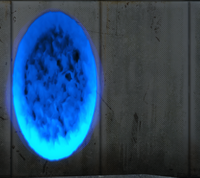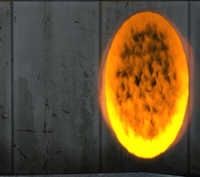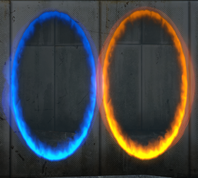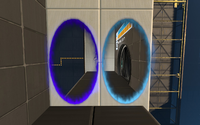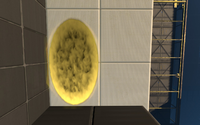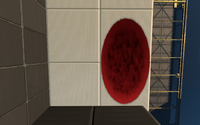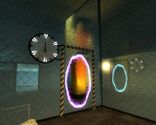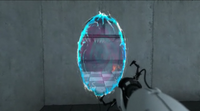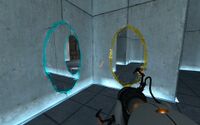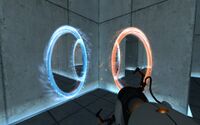Portals: Difference between revisions
m Minor tweaks. And someone may wish to double-check the portal colours, 'cause I changed 'em after viewing the screenshots. Of course the colours could be incorrect on this cheap (work) TN panel... |
unconstructive edit Tag: Manual revert |
||
| (97 intermediate revisions by 43 users not shown) | |||
| Line 1: | Line 1: | ||
[[Image:P-Body_Portals.png|350px|right|thumb|A curious [[P-body]] testing and playing with the Portal Gun.]] | |||
[[Image:P-Body_Portals.png|350px|right|thumb|P-body testing the | |||
{{Quotation|'''GLaDOS'''|Momentum, a function of mass and velocity, is conserved between portals. In layman's terms: Speedy-thing goes in, speedy-thing comes out.|sound=GLaDOS_06_part1_success_2-1.wav}} | {{Quotation|'''GLaDOS'''|Momentum, a function of mass and velocity, is conserved between portals. In layman's terms: Speedy-thing goes in, speedy-thing comes out.|sound=GLaDOS_06_part1_success_2-1.wav}} | ||
== | '''Portals''' are the primary gameplay [[Mechanics|mechanic]] of the ''Portal'' series. Portals can only be placed on white, stationary (except for one occasion in [[Portal 2|Portal 2]]), flat surfaces by an [[Aperture Science Handheld Portal Device]], and works in pairs thereby allowing two-way movement through each portal. | ||
== Overview == | |||
Portals act as a direct link between one another. Anything that goes into one portal comes instantly out the other. Objects going at high speed into a portal (such as falling into one from great height) will maintain their speed when coming out of the other, giving the player the ability to launch themselves or other objects through the air. Portals are also capable of continuing any sort of beam, specifically the [[Excursion Funnel]]s, [[Thermal Discouragement Beam]]s, and [[Hard Light Bridge]]s. If only one portal in a pair exists at the moment, the existing portal is an oval completely filled in with color. When attempting to enter an unpaired portal, it will act as a solid wall. When both portals in a pair exist, they will appear to be like windows. When looking through one portal, you can see directly out the other. When a portal is linked, you can identify which portal it is by looking at its colored border. | |||
Once the player obtains the Portal Device, they can create a portal on a surface by aiming at the spot they want to put the portal and pressing the primary or secondary fire key. If the player has only acquired the Single Portal Device, both fire keys produce the primary portal color. If they have acquired the Dual Portal Device, the primary fire key produces the primary color and the secondary fire key produces the secondary color. Portals cannot be placed on surfaces that are not made of the appropriate material (white walls usually indicate this material), moving, not flat, or not large enough for a portal to fit onto it. Portals can be placed on surfaces made out of concrete {{Spoiler| or moon rocks, as stated by Cave Johnson in ''[[Portal 2]]''. }} Portals also cannot be placed while looking through currently existing portals. | |||
Portals are very likely moving at the [[Wikipedia:Speed of light|speed of light]]{{Spoiler|, this is proven by the time taken to shoot a portal to the moon in the finale of ''[[Portal 2]]''.}} | |||
Portals transmit matter and light, this is proven by the fact that {{Tooltip|Excursion Funnels, Thermal Discouragement Beams and Hard Light Bridges|GLaDOS claimed that these matters are made from pure light}} can pass through portals | |||
In ''[[Portal]]'' and the single-player campaign of ''[[Portal 2]]'', protagonist and test subject [[Chell]] can create blue (primary) and orange (secondary) portals with her version of the Dual Portal Gun. In ''Portal 2''<nowiki>'</nowiki>s [[co-op]] campaign, each robot test subject possesses individual portal colors in order to differentiate them; [[Atlas]] creates cyan (primary) and indigo (secondary) portals, whereas [[P-body]] creates yellow (primary) and red (secondary) portals. | |||
=== Pre-release designs === | |||
The portals have had several changes in design before the final release of ''Portal'' in October 10, 2007, as evident in some trailers and screenshots.<ref>[http://www.youtube.com/watch?v=TluRVBhmf8w portal orientation video 1] on YouTube.com</ref> Even Earlier development screenshots from ''Portal'' revealed that the original colors for the portals were light blue (primary-fire) and purple (secondary-fire), with the portals more resembling like rifts ripped into a dimension than the simpler oval designs in the current series. Later, the purple color was replaced with red, akin to [[P-Body]]'s secondary-fire in ''Portal 2''. At some point, the developers decided to maintain the blue and orange color schemes previously used as portals in ''[[Narbacular Drop]]''. | |||
==Portal 2== | |||
{{spoiler|[[Atlas]] and [[P-body]] should enter even portals one after another otherwise they may collide which may even cause death one or both ([[Portal 2 Co-op Course 3 Chamber 4]]).<ref>[[March 25, 2023 Patch]] or [[version]] "Protocol version 2001, Exe version 2.0.0.1 (portal2), Exe build: 19:15:46 Mar 3 2023 (8873) (620)"</ref> One can constantly jump and second can crouch before [[flinging]].}} | |||
== Gameplay exploits== | |||
=== Reportalling === | |||
With some movements, the player is able to boost their momentum when traveling through two portals placed on the floor by using their primary or secondary fire key as they exit the portal they are going through, respectively. This is caused by the portals giving a push to the player from a portal if the portal is re-placed somewhere else (or in this case, in the same place). | |||
=== Portal bumping === | |||
When placing a portal onto another portal, the other portal will get bumped to a position that is next to the first placed one. By using this glitch, players can skip some chambers in both games - [[Portal Test Chamber 16]] (just the first speech and the glass clip), [[Portal Test Chamber 17]] (all the way to the incinerator room), and in the second game the player can get into some observation rooms with this glitch (for example, the one in the first laser relay map). | |||
== Tips == | |||
{{spoiler|An unpaired [[portal]] can be beneficial later ([[Portal 2 Co-op Course 3 Chamber 2]]).}} | |||
== Notes == | |||
{{Spoiler|block=yes| | |||
* There is no difference between the two modes of [[Aperture Science Handheld Portal Device]] and two kinds of portals in [[Portal 2]]. | |||
}} | |||
== Gallery == | == Gallery == | ||
=== Portal colors === | |||
{{Gallery | |||
|lines = 1 | |||
|height = 178|width=200 | |||
|title = [[Chell]]'s portals | |||
|File:Chell_lmb_portal.png|alt1=C|An unpaired primary-fire portal | |||
|File:Chell_rmb_portal.png|alt2=C|An unpaired secondary-fire portal | |||
|File:Chell_both_portal.png|alt3=C|Both portals | |||
|File:Portal 2 Chapter 1 Introduction test chamber.png|alt4=C|Portals seen in a test chamber. | |||
}} | |||
</ | {{Gallery | ||
|lines = 1 | |||
|height = 125 | |||
|width = 200 | |||
|title = [[Atlas]]' portals | |||
|File:Atlas_lmb_portal.png|alt1=A|An unpaired primary-fire portal | |||
|File:Atlas_rmb_portal.png|alt2=A|An unpaired secondary-fire portal | |||
|File:Atlas_both_portal.png|alt3=A|Both portals | |||
}} | |||
{{Gallery | |||
|lines = 1 | |||
|height = 125 | |||
|width = 200 | |||
|title = [[P-Body]]'s portals | |||
|File:P-body_lmb_portal.png|alt1=P|An unpaired primary-fire portal | |||
|File:P-body_rmb_portal.png|alt2=P|An unpaired secondary-fire portal | |||
|File:P-body_both_portal.png|alt3=P|Both portals | |||
}} | |||
=== Pre-release designs === | |||
{{Gallery | |||
|lines = 4 | |||
|height = 125 | |||
|width = 200 | |||
|title = [[Chell]]'s portals | |||
|File:2005 beta portals.jpg|alt1=Beta portals|Both portals from the early 2005 beta. | |||
|File:Cyan and purple portals.jpg|alt2=Beta portals|Another view of the 2005-era portals. | |||
|File:Portal_betaportal.png|alt3=Beta portals|Primary-fire 'vine' portal rift as seen in the [[Portal Teaser Trailer (video)|Orientation Video]] teaser trailer. | |||
|File:Vine_portals.jpg|alt4=Beta Portals|Another view of the 'vine' portal rifts.. | |||
|File:Portal betaportal2.png|alt5=Beta portals|A dated screenshot from the Steam Store depicting early portals of the "swirl" portals, now bearing a proper oval shape. | |||
|File:Scott_swirl_portals.jpg|alt6=Beta portals|Another view of the 'swirl' portals. | |||
}} | |||
== Closed Captions == | |||
* Portal Opening | |||
* Portal Closing | |||
== Trivia == | |||
* This mechanic was originally inspired by the game [[Narbacular_Drop|Narbacular Drop]]. | |||
== References == | |||
<references/> | |||
{{MechanicsNav}} | {{MechanicsNav}} | ||
[[Category:Mechanics]] | [[Category:Mechanics]] | ||
Latest revision as of 10:21, 16 August 2025
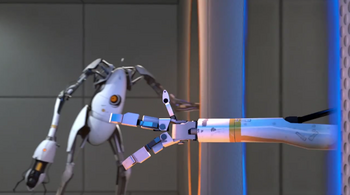
| “ | Momentum, a function of mass and velocity, is conserved between portals. In layman's terms: Speedy-thing goes in, speedy-thing comes out.
— GLaDOS
|
” |
Portals are the primary gameplay mechanic of the Portal series. Portals can only be placed on white, stationary (except for one occasion in Portal 2), flat surfaces by an Aperture Science Handheld Portal Device, and works in pairs thereby allowing two-way movement through each portal.
Overview
Portals act as a direct link between one another. Anything that goes into one portal comes instantly out the other. Objects going at high speed into a portal (such as falling into one from great height) will maintain their speed when coming out of the other, giving the player the ability to launch themselves or other objects through the air. Portals are also capable of continuing any sort of beam, specifically the Excursion Funnels, Thermal Discouragement Beams, and Hard Light Bridges. If only one portal in a pair exists at the moment, the existing portal is an oval completely filled in with color. When attempting to enter an unpaired portal, it will act as a solid wall. When both portals in a pair exist, they will appear to be like windows. When looking through one portal, you can see directly out the other. When a portal is linked, you can identify which portal it is by looking at its colored border.
Once the player obtains the Portal Device, they can create a portal on a surface by aiming at the spot they want to put the portal and pressing the primary or secondary fire key. If the player has only acquired the Single Portal Device, both fire keys produce the primary portal color. If they have acquired the Dual Portal Device, the primary fire key produces the primary color and the secondary fire key produces the secondary color. Portals cannot be placed on surfaces that are not made of the appropriate material (white walls usually indicate this material), moving, not flat, or not large enough for a portal to fit onto it. Portals can be placed on surfaces made out of concrete or moon rocks, as stated by Cave Johnson in Portal 2. Portals also cannot be placed while looking through currently existing portals.
Portals are very likely moving at the speed of light, this is proven by the time taken to shoot a portal to the moon in the finale of Portal 2.
Portals transmit matter and light, this is proven by the fact that Excursion Funnels, Thermal Discouragement Beams and Hard Light Bridges can pass through portals
In Portal and the single-player campaign of Portal 2, protagonist and test subject Chell can create blue (primary) and orange (secondary) portals with her version of the Dual Portal Gun. In Portal 2's co-op campaign, each robot test subject possesses individual portal colors in order to differentiate them; Atlas creates cyan (primary) and indigo (secondary) portals, whereas P-body creates yellow (primary) and red (secondary) portals.
Pre-release designs
The portals have had several changes in design before the final release of Portal in October 10, 2007, as evident in some trailers and screenshots.[1] Even Earlier development screenshots from Portal revealed that the original colors for the portals were light blue (primary-fire) and purple (secondary-fire), with the portals more resembling like rifts ripped into a dimension than the simpler oval designs in the current series. Later, the purple color was replaced with red, akin to P-Body's secondary-fire in Portal 2. At some point, the developers decided to maintain the blue and orange color schemes previously used as portals in Narbacular Drop.
Portal 2
Atlas and P-body should enter even portals one after another otherwise they may collide which may even cause death one or both (Portal 2 Co-op Course 3 Chamber 4).[2] One can constantly jump and second can crouch before flinging.
Gameplay exploits
Reportalling
With some movements, the player is able to boost their momentum when traveling through two portals placed on the floor by using their primary or secondary fire key as they exit the portal they are going through, respectively. This is caused by the portals giving a push to the player from a portal if the portal is re-placed somewhere else (or in this case, in the same place).
Portal bumping
When placing a portal onto another portal, the other portal will get bumped to a position that is next to the first placed one. By using this glitch, players can skip some chambers in both games - Portal Test Chamber 16 (just the first speech and the glass clip), Portal Test Chamber 17 (all the way to the incinerator room), and in the second game the player can get into some observation rooms with this glitch (for example, the one in the first laser relay map).
Tips
An unpaired portal can be beneficial later (Portal 2 Co-op Course 3 Chamber 2).
Notes
- There is no difference between the two modes of Aperture Science Handheld Portal Device and two kinds of portals in Portal 2.
Gallery
Portal colors
| Chell's portals | |||||||||
| |||||||||
| Atlas' portals | |||||||||
| |||||||||
| P-Body's portals | |||||||||
| |||||||||
Pre-release designs
| Chell's portals | ||||||||||
| ||||||||||
Closed Captions
- Portal Opening
- Portal Closing
Trivia
- This mechanic was originally inspired by the game Narbacular Drop.
References
- ↑ portal orientation video 1 on YouTube.com
- ↑ March 25, 2023 Patch or version "Protocol version 2001, Exe version 2.0.0.1 (portal2), Exe build: 19:15:46 Mar 3 2023 (8873) (620)"
